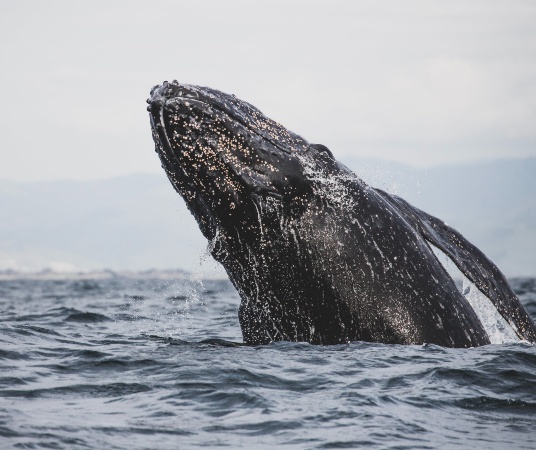From zombie viruses to sex-changing lizards: when the climate disorients nature
The planet is warming up and life is losing its atmospheric references. Today we bring you 5 strange occurrences that are already happening in nature due to climate change.
Imagine life on our planet as a delicate chain of perfectly aligned dominoes. If a single piece wobbles and falls, it triggers a domino effect that causes all the others to fall. Now, visualise climate change as an invisible hand that is giving the first push, unleashing a cascade of events that Mother Nature had not anticipated. This is what we know as climate anomalies, the effects that rising global temperatures are already having on the flora and fauna around us.
What will I read in this article?
- Melting ice releases ancient viruses
- Whales die without food
- Lizards change sex
- Plants bloom too early
- Wine does not keep
The resurgence of zombie viruses
This heading sounds like the title of a bad B-movie, but unfortunately it has much more to do with reality than fiction. By raising temperatures and melting glaciers, global warming is awakening what are known as "zombie viruses". The term refers to ancient viruses that have lain dormant in the ice for long periods of time but are now being released due to accelerated thawing after thousands of years trapped in the permafrost.
They are not dead but have been in a state of ‘suspension’ due to low temperatures. As the permafrost melts due to global warming, these viruses may re-emerge and become a global health problem once more.
Grey whales are running out of food
 Others experiencing problems due to the meltdown are grey whales. A team of researchers from Oregon State University discovered that when the delicate balance of ice in the Arctic changes, it can leave whales without enough food or access to it. The study, published in the journal Science, points out that the lack of ice causes less algae to grow under the ice sheets. Amphipods (small shrimp-like animals) depend on these algae for food. So, if there are fewer algae, there are also fewer amphipods.
Others experiencing problems due to the meltdown are grey whales. A team of researchers from Oregon State University discovered that when the delicate balance of ice in the Arctic changes, it can leave whales without enough food or access to it. The study, published in the journal Science, points out that the lack of ice causes less algae to grow under the ice sheets. Amphipods (small shrimp-like animals) depend on these algae for food. So, if there are fewer algae, there are also fewer amphipods.
This is a problem for the whales, because amphipods are a major part of their diet. Furthermore, the warmer Arctic water and faster currents have led to the arrival of other animals that compete for the same food source.
Between 2016 and 2023, the eastern North Pacific grey whale population dropped by nearly half, from a peak of 27,000 to approximately 14,500 today, according to the most recent data from the National Oceanic and Atmospheric Administration (NOAA).
Gender-switching lizards
Climate change is also having a surprising impact on some reptile species, including the bearded dragon (pogona vitticeps), native to Australia. According to several studies, the change in environmental temperature can cause genetically male lizards to turn into females.
The sex of the embryo of these reptiles can be determined by the ambient temperature during a critical stage of their development. The research, published in The Royal Society, found that if eggs with typically male sex chromosomes were incubated in a nest at 32°C or above they emerged as females. Below that temperature, the sex seemed to be completely determined by their genetics.
"The change in environmental temperature can cause genetically male lizards to become females."
The risk, according to scientists, is that as temperatures continue to rise the male population of certain species could decline significantly. That situation that could lead to a real risk of extinction.
Plants that flower early
In Japan, cherry trees are famous for their spring blossom, an event celebrated throughout the country in hanami festivals. In 2020, however, there were reports of cherry blossom in autumn, a very unusual phenomenon that experts attribute to extreme weather conditions. High temperatures followed by thunderstorms can trick trees into thinking that winter has passed, causing early flowering.
The Japanese case is not anecdotal. High temperatures change the rhythms of many plants, which flower earlier in the face of mild autumns and winters. This January in Spain specimens of almond trees were detected in flower with green leaves from last season. These leaves should have disappeared in late autumn or early winter. In addition, the first flowers have emerged 16 days before 7 February, the approximate date of the beginning of flowering over the last three decades.
“High temperatures followed by thunderstorms can trick trees into thinking that winter has passed, causing early flowering."
These are not unimportant anomalies, they are part of a larger chain: that of ecosystem services. The interactions of the natural world generate services we use every day that benefit us all. What happens if flowers open during the winter, when insects have not appeared yet? There would be no pollination and the food chain would be affected.
The higher the temperature, the worse the wine
Despite the fact that we are not yet experiencing a drop in the production of fruit or vegetables due to rising temperatures, we are seeing how they can lose quality. This is the case of grapes, for example. These wonders of nature that allow us to enjoy the best wines in the world are very sensitive to temperature changes. They may rot or fail to ripen if conditions are not suitable.
It is estimated that for every one degree Celsius increase in the average temperature the harvest is brought forward by about one week. This change in the life cycle of the grape can have a significant impact on the quality of the wine produced.
The climate anomalies we are experiencing are a clear warning sign of the profound transformation our planet is undergoing due to rising temperatures worldwide. Extreme heat and cold events, unexpected floods and droughts, and changes in wildlife patterns are just some of the visible effects of this phenomenon.
Sources:
- https://elpais.com/clima-y-medio-ambiente/2024-01-29/toca-florecer-ya-el-calor-en-pleno-invierno-desorienta-a-las-plantas.html
- https://www.sostenibilidad.com/medio-ambiente/abejas-ciudad/


